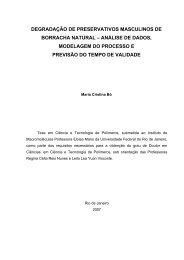EXAFS as a tool for catalyst characterization: a review of the ... - INT
EXAFS as a tool for catalyst characterization: a review of the ... - INT
EXAFS as a tool for catalyst characterization: a review of the ... - INT
Create successful ePaper yourself
Turn your PDF publications into a flip-book with our unique Google optimized e-Paper software.
The X-ray absorption coefficient <strong>for</strong> an atom decre<strong>as</strong>es <strong>as</strong> <strong>the</strong> X-ray<br />
energy incre<strong>as</strong>es. It displays discontinuities (absorption edges) <strong>as</strong> an<br />
incident photon is absorbed by <strong>the</strong> atom and electronic transitions<br />
from a core atomic level to unoccupied conduction states above <strong>the</strong><br />
Fermi level take place.<br />
The photoelectron emitted in this process can be represented <strong>as</strong> a<br />
wave. If <strong>the</strong> excited atom is surrounded by o<strong>the</strong>r atoms, <strong>the</strong> outgoing<br />
wave scatters from <strong>the</strong> surrounding atoms, producing ingoing waves.<br />
These ingoing waves can constructively or destructively interfere with<br />
<strong>the</strong> outgoing waves. This interference produces <strong>the</strong> oscillatory<br />
behavior <strong>of</strong> <strong>the</strong> fine structure.<br />
The extended X-ray absorption fine structure (<strong>EXAFS</strong>) is <strong>the</strong><br />
oscillation in <strong>the</strong> absorption coefficient on <strong>the</strong> high-energy side <strong>of</strong> X-<br />
ray absorption edges, ranging from 30 to about 1000eV above <strong>the</strong><br />
edge. Stern, Sayers and Lytle related <strong>the</strong>se fluctuations <strong>of</strong> <strong>the</strong><br />
absorption coefficient to <strong>the</strong> atomic arrangement surrounding <strong>the</strong><br />
absorbing atom (Stern, 1974; Stern et al., 1975; Lytle et al., 1975).<br />
In this paper, we will be concerned with nei<strong>the</strong>r <strong>the</strong> <strong>the</strong>ory <strong>of</strong> <strong>EXAFS</strong><br />
(Stern, 1974) nor <strong>the</strong> experimental techniques used to me<strong>as</strong>ure<br />
<strong>EXAFS</strong> (Lytle et al., 1975; Meitzner, 1998). The aim <strong>of</strong> this work is to<br />
<strong>review</strong> <strong>the</strong> ma<strong>the</strong>matical procedure <strong>for</strong> treating <strong>the</strong> <strong>EXAFS</strong> spectrum<br />
in order to calculate <strong>the</strong> physical parameters. A final section presents<br />
one example <strong>of</strong> <strong>EXAFS</strong> application to catalysis.<br />
Data Analysis<br />
An X-ray absorption experiment involves <strong>the</strong> me<strong>as</strong>urement <strong>of</strong> <strong>the</strong><br />
total linear absorption coefficient, µ, <strong>as</strong> <strong>the</strong> photon energy is varied.<br />
In <strong>the</strong> c<strong>as</strong>e <strong>of</strong> a transmission experiment,<br />
ln I 0 /I = µ x (1)<br />
where I 0 and I are <strong>the</strong> photon intensities be<strong>for</strong>e and after <strong>the</strong><br />
absorber <strong>of</strong> thickness x.<br />
A typical X-ray absorption spectrum can be separated into four parts<br />
(Bart and Vlaic, 1987) (Figure 1):<br />
a- pre-edge region;<br />
b- edge region;<br />
c- X-ray absorption near edge structure (XANES) region;<br />
d- extended X-ray absorption fine structure (<strong>EXAFS</strong>) region.







![ABM 2012 Torquímetros 20801[1].pdf - INT](https://img.yumpu.com/35773768/1/184x260/abm-2012-torquimetros-208011pdf-int.jpg?quality=85)




![Resumo biodiesel 2012 Raquel Rev cla[1].pdf - INT](https://img.yumpu.com/27723744/1/184x260/resumo-biodiesel-2012-raquel-rev-cla1pdf-int.jpg?quality=85)



